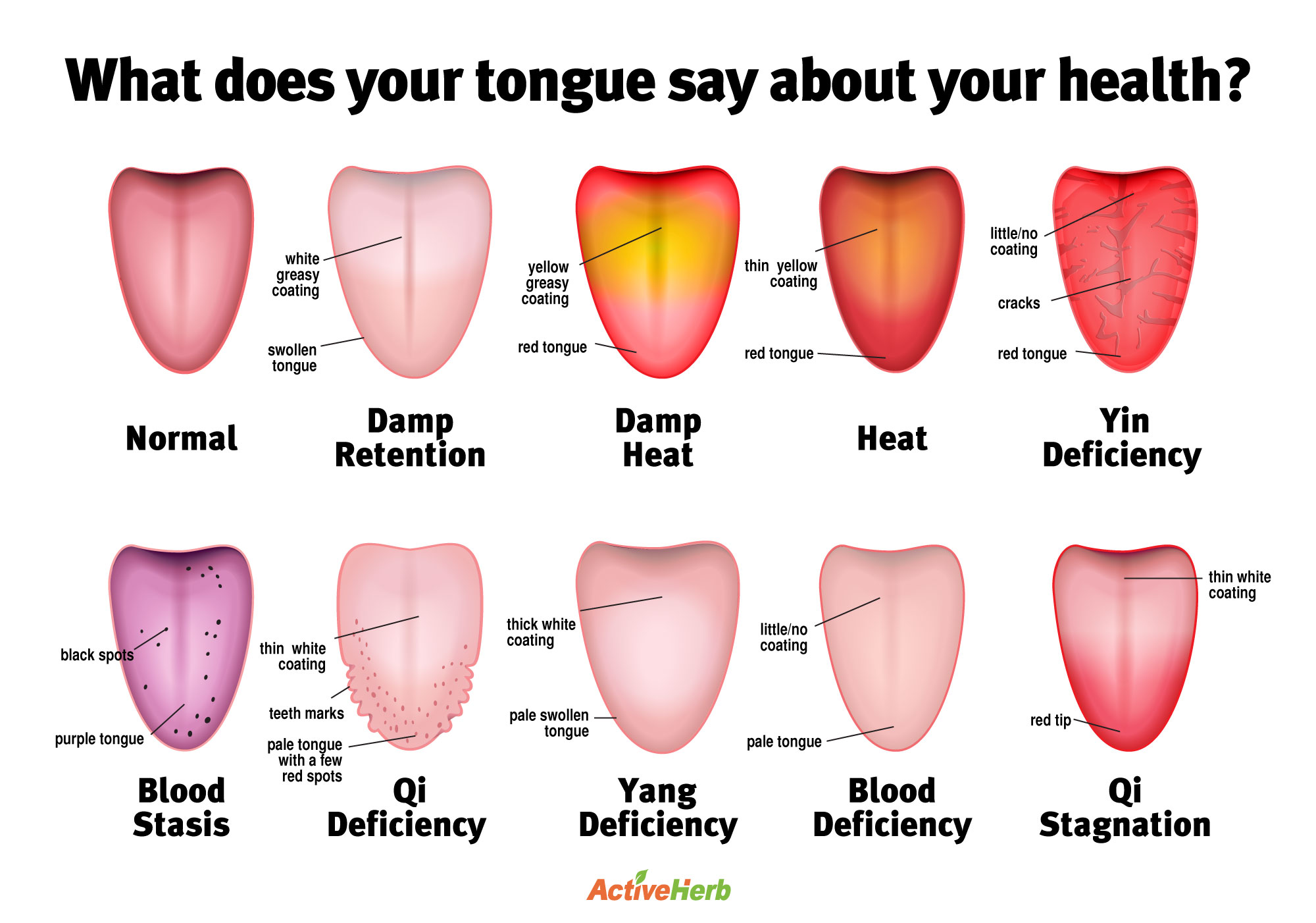What Your Tongue Says About Your Health In Chinese Medicine

If the eyes are the window to the soul, the tongue is the window to the body, at least in traditional Chinese medicine (TCM). The tongue is to TCM what a stethoscope, ophthalmoscope and otoscope is to Western medicine—and all a qualified TCM expert (licensed acupuncturist, old-school TCM doctor or Doctor of Oriental Medicine) needs to examine the tongue is a functioning set of eyes.
For at least 3,000 years, tongue diagnosis has provided a simple yet highly effective diagnostic tool. Almost without fail (no method of medicine or diagnosis is 100% perfect), analyzing a patient’s tongue provides accurate insight into the condition of a patient, even for complex conditions.
In comparison to pulse diagnosis, the other main diagnostic tool in TCM, tongue examinations are much easier to learn for newbies learning classic Oriental medicine. And you, too, can learn the basics of tongue diagnosis.
So stick out your tongue in the mirror and see if one of these pics matches your tongue…
TCM Tongue Diagnosis Basics
First, let’s review precisely what TCM practitioners are looking at when they tell you to stick out your tongue and say “ah.” Actually, strike that last part, that’s only in Western medicine.
When you stick out your tongue, a TCM practitioner takes note of the following:
- The coating on top of the tongue
- If there is a furriness to the coating
- The color
- Size of the crack
- Bumps
- Saliva levels
Like the feet in reflexology, the tongue represents in TCM theory a map of the organs and meridian system. Likewise, in Western medicine, the tongue may offer some diagnostic value. For instance, if a person has an overgrowth of Candida yeast, white bumps may form on the tongue.
Now then, let’s see what tongue you have.

Normal
A normal tongue looks pretty in pink, with minimal or no crack in the middle, a normal amount of saliva, no sores and a minimal amount of white coating.
Damp Retention
One of the most common TCM diagnoses is dampness retention, which manifests as bloating, lethargy and a feeling of heaviness, to name a few symptoms. A tongue indicative of this TCM pattern appears a bit swollen with a thick white greasy coating.
Damp Heat
When someone is hot-headed and angry, their tongue is a reflection of their emotions. In TCM theory, frequent anger is a sure-fire sign of damp heat, which can also be caused by eating lots of heavily-cooked meats (barbecue) as well as cold foods and drinks (ice cream, beer, soda). Besides having a beet-red tongue, a tell-tale sign of Damp Heat is a yellowish, greasy coating. Other manifestations of this pattern include skin problems and urinary tract infections.
Heat
Just like in weather patterns, heat can accompany damp conditions or dry ones. The TCM pattern of “Heat” is associated with the dryness, which not surprisingly manifests as thirst, as well as constipation. A tongue indicative of Heat pattern is also red but with a thinner yellow coating than Damp Heat.
Yin Deficiency
Yin Deficiency essentially means the body’s cooling engine isn’t working. That’s why night sweats and hot flashes are common symptoms of this TCM pattern. Like a Heat and Damp Heat tongue, a Yin Deficiency tongue appears bright red. Cracks may be present all over the tongue, not just in the middle of the organ. There’s also very little or no coating.
Blood Stasis
What’s more colorful than a red tongue? An eggplant/purplish hue. While purple might be an attractive color elsewhere in nature, say, on a flower, on a tongue, it’s an indication of a serious issue with blood circulation. Unfortunately, because of the prevalence of sedentary lifestyles coupled with lack of exercise, many people have purple tongues with black spots, sure signs of blood stasis.
Qi Deficiency
The hallmark symptom of this pattern is tiredness. And a Qi Deficiency tongue mirrors the lack of vibrancy. The tongue appears pale with a thin white coating.
Yang Deficiency
If Yin Deficiency is a lack of cooling energy, a deficiency of yang energy is the opposite. If you feel cold even if the weather is pleasant, you may have this pattern. Like Qi Deficiency and Blood Deficiency (see below), a Yang Deficiency tongue is pale. A thick white coating lines the top of the tongue with this pattern. Other physical manifestations of this pattern include back pain and a pale complexion.
Blood Deficiency
The paleness of a Blood Deficiency tongue is accompanied by an absence of a coating. This pattern arises when not enough Blood is manufactured, a condition caused by Spleen Qi Deficiency. Spleen is the organ in TCM that transforms nutrients from food into Qi energy and Blood. Poor cognitive function, dizziness, fatigue and insomnia are common manifestations of this pattern.
Qi Stagnation
When energy is stuck in one or more organ systems, this is indicative of Qi Stagnation. With this pattern, the tongue appears normal in the back three-quarters of the muscle (yes, the tongue is technically a muscle). But the tip and first quarter closest to the entrance of the mouth is bright red. Stress and emotional instability cause this pattern.
Tongue Diagnosis: Conclusion
So what TCM tongue do you have? If you don’t have a normal tongue, no need to panic. Chinese herbs may help restore balance in your body, and one day, you may enjoy sticking your pink, crack-free tongue out. In the meantime, visit our Health topics page, where you’ll find natural herbal formulas for these TCM patterns.





